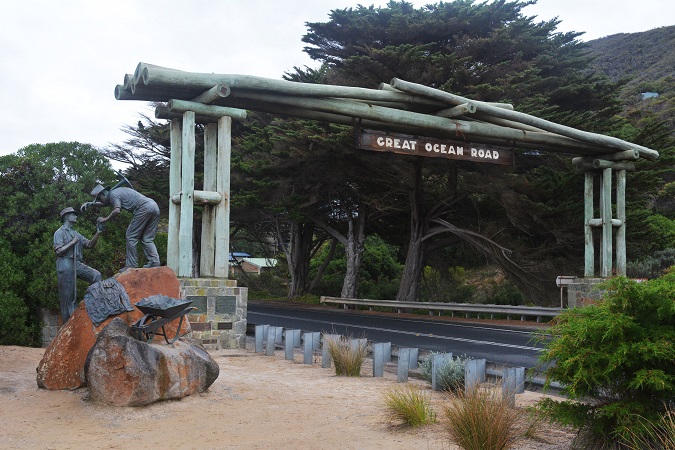
One of the World’s Great Scenic Drives
Great Ocean Road
Updated Apr 2022
The Great Ocean Road is not just a road. It is one of the world’s great scenic drives. Starting from the town of Torquay, on the coast southwest of Melbourne, The Great Ocean Road stretches 244 kilometres (151miles) to the town of Allansford (near Warrnambool) in the west.
After the First World War, the Great Ocean Road began as a make-work project for returning Australian servicemen. The idea was to give them temporary employment until they could readjust to civilian life and find other work. Besides, there was no access at this time to the south coast except by boat or rough track. So the entire road was created with manual labour using picks, shovels and wheelbarrows. Work began in September 1919 and was completed in 1932.
Upon completion, the road was dedicated to the Australian servicemen who never returned from the Great War. It is the world’s longest war memorial.
When the road opened, it was still not an easy thing to travel. It consisted of only one lane and was made of dirt, gravel, and rocks. If one met an oncoming vehicle, one person would have to find somewhere to get off the road to allow the other to pass. In addition, there was a toll to use the road until 1936.
The Modern Great Ocean Road
Today the Great Ocean Road is a tourist route and an ordinary highway for Australians to travel along the coast. Here are some of the highlights for tourists to see along the way.
Split Point
At Split Point, there is a short hike up to a lighthouse. It costs $14 to go up the lighthouse, so we didn’t bother, but it is still a nice little walk, and there is an excellent viewpoint where you can see up and down the coast. You can walk up the road and walk back on a nice path through the woods.
Teddy’s Lookout
At Lorne, stop at the Visitor’s Centre and ask for directions to Teddy’s Lookout. You will have a fantastic view of the coast and the Great Ocean Road below.
Kennett River Campground
You can travel the whole of the Great Ocean Road in one day, but that would be a shame. There are many things to see along the way. There are some lovely beaches to stop for picnics or a swim, and there are some excellent places to see some of Australia’s wildlife. One such spot is the Kennett River Campground (which offers both camping and cabins for rent). Living in the campground are several Koalas and many big, beautiful, bright red Australian King Parrots. Both of which are very tame.
The 12 Apostles
The 12 Apostles are limestone stacks reaching up to 50 metres tall. Over thousands of years, they were carved out of the shore by the waves. Where the 12 Apostles stand now was once the shoreline. However, the water is still eating away at them. As the waves carve away the base of the stack, it will eventually collapse. Today only eight apostles remain. The ninth one collapsed in 2005. You can see the small pile of rocks in the photo where it once stood.
London Bridge
London Bridge was a small peninsula carved out of the shoreline by the waves. Then the water cut some holes through it, creating arches. The result was something that resembled the old London Bridge in England. Half of it collapsed, leaving just an island with an arch in it. Two tourists were stranded on the island when the arch collapsed and had to be rescued by helicopter. Luckily, they were not standing on the part that fell into the sea and washed away.
The Razorback
So named because of its jagged ridge, the Razorback is a narrow island jutting out into the sea. It was once part of the mainland. It used to be much longer, but the sea is tearing away chunks at its tip. You can see pieces there that fell into the sea, making the Razorback shorter and shorter until it will be gone one day.
Other Sights
This is by no means an inclusive list of sights along the Great Ocean Road. Boat Bay, Loch Ard Gorge and Bay of Islands are a few others.
Erosion
Each wave that hits the shore or one of the stacks or islands goes back with a handful of sand. Eventually, all the stacks, arches and islands will collapse. But then the waves will eat into the shoreline, creating new ones. This is already happening in places. The shore is receding by about 2 cm per year. It is a never-ending process. Check back in 1,000 years, and you will see how different the area looks from what you see today.
Photography
To get the best photos of the 12 Apostles and other sights along the Great Ocean Road, you need to get up early. You will see many beautiful images of the area on postcards in the stores, but you may be disappointed that it does not look like that when you go there.
To get beautiful photos, you need to be there on a sunny day at sunrise. The day that I went, there was a crowd of about 100 photographers there at dawn. By 7 a.m., most of them were gone. Hundreds of tourists arrive in the afternoon and see the 12 Apostles when they are primarily dark grey due to the sun being on the other side, or it is a gloomy day with no sun at all. A bright sunny day is almost as bad. Too much sun will cause the photos to be washed-out and mostly colourless. The sun at sunrise casts an orange light over the shore. That is the time to be there and get great photos.
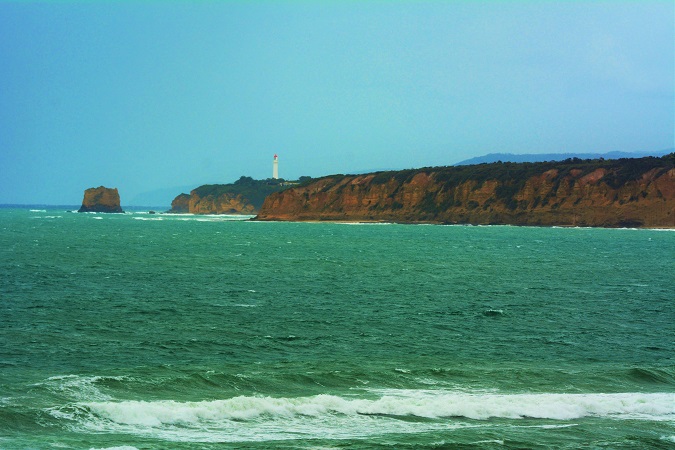
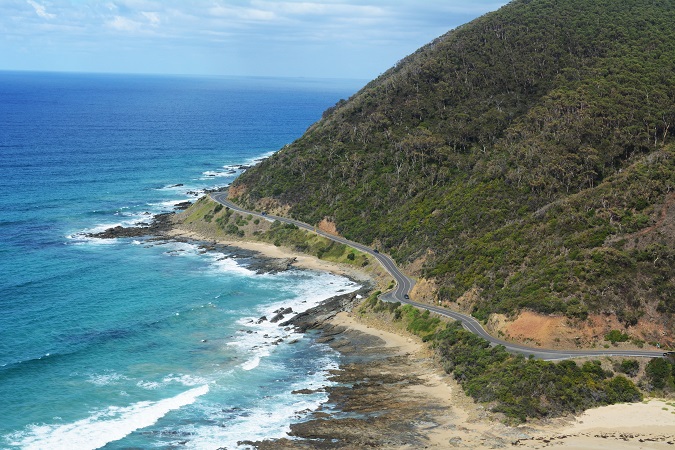

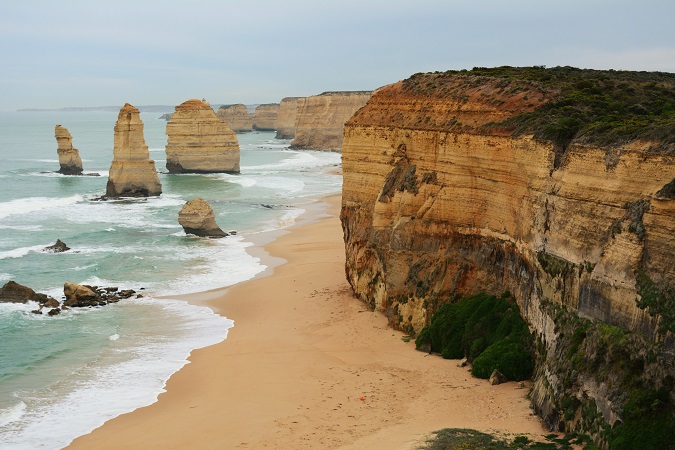
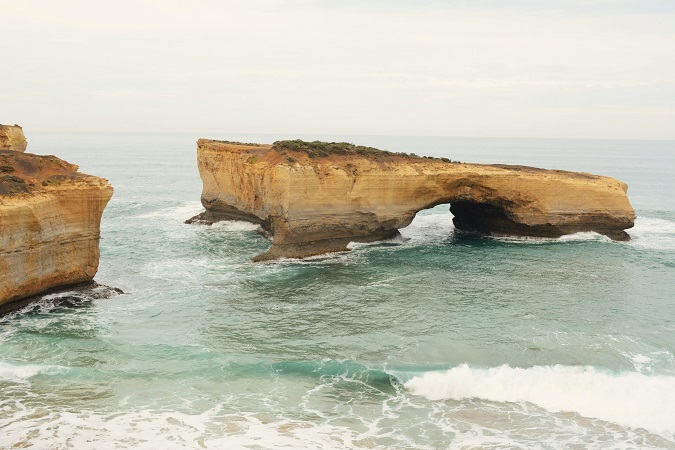
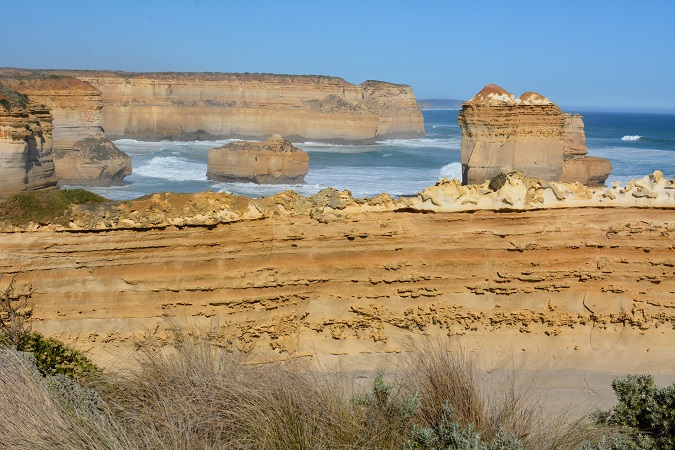
perfect road to ride a motorhome. Have yo swum in these beaches?
No, it is far too cold to go swimming. Sleeping with my sweater on at night, inside a sleeping bag. I thought Australia was a hot country!